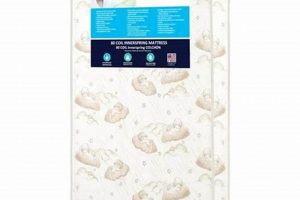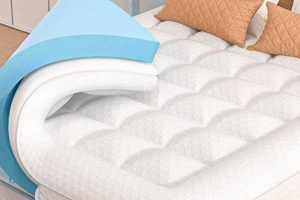A sleeping surface addition crafted from untreated cotton, designed to be placed atop a mattress. It provides an extra layer of cushioning and can influence the thermal properties of the sleep environment. An example would be a quilted covering filled with unbleached cotton fibers secured to a mattress with elastic straps.
The significance of such bedding lies in its potential to enhance sleep quality and reduce exposure to synthetic materials. Advantages include improved breathability compared to synthetic alternatives, potentially leading to a cooler sleep experience. Historically, natural fibers like cotton have been favored for bedding due to their perceived comfort and hypoallergenic properties.
The following sections will delve into the selection criteria, maintenance considerations, and comparative analysis of different types of mattress enhancements, focusing on the properties and benefits associated with those utilizing plant-based materials.
Selecting and Maintaining Cotton Mattress Overlays
The following guidance aims to inform consumers about the crucial aspects of choosing and caring for a sleeping surface enhancement made from untreated cotton. Proper selection and maintenance are essential for maximizing its lifespan and benefits.
Tip 1: Fiber Source Verification: Prioritize products that specify the cotton source and certifications, such as GOTS (Global Organic Textile Standard). This ensures the cotton is organically grown and processed, minimizing chemical exposure.
Tip 2: Density and Loft Considerations: Evaluate the fill power and loft based on desired firmness. Higher density generally provides more support, while lower density offers a softer feel. Consider weight distribution needs.
Tip 3: Ticking Fabric Evaluation: Examine the outer fabric or “ticking.” Opt for tightly woven cotton or linen to prevent fiber migration and enhance durability. Avoid synthetic blends if prioritizing breathability.
Tip 4: Allergen Awareness: While cotton is generally hypoallergenic, consider dust mite resistance. Look for features such as tightly woven fabric or washable options to mitigate dust mite accumulation.
Tip 5: Regular Cleaning Protocols: Follow manufacturer instructions for cleaning. Spot clean spills promptly. Airing the item regularly in sunlight can help eliminate odors and inhibit mold growth.
Tip 6: Proper Storage Practices: When not in use, store the item in a breathable cotton bag in a cool, dry place. Avoid plastic bags, which can trap moisture and lead to mildew.
Tip 7: Assess Thickness and Edge Construction: The thickness of the mattress overlay impacts the change to the bed’s overall feel. Assess how the edge is constructed to make sure it is of high quality and will resist wear and tear.
Adhering to these recommendations will contribute to a longer product lifespan, improved sleep quality, and a reduced risk of exposure to harmful chemicals. Furthermore, proper maintenance ensures the continued comfort and hygiene of the sleep surface.
The subsequent sections will explore comparative analyses with other mattress enhancement materials and address common misconceptions surrounding natural fiber bedding.
1. Breathability
Breathability, concerning mattress overlays composed of untreated cotton, directly impacts the microclimate of the sleep environment. The inherent structure of the cotton fibers allows for air circulation, which influences temperature regulation and moisture management.
- Fiber Structure and Airflow
The natural crimp and hollow structure of cotton fibers create pathways for air movement within the material. This allows warm air and moisture vapor produced by the body during sleep to dissipate, preventing heat buildup. In contrast, synthetic fibers often lack this inherent airflow capacity, potentially leading to a warmer, less comfortable sleep experience.
- Moisture Wicking Capability
Cotton possesses hydrophilic properties, meaning it can absorb moisture. This absorption, coupled with the aforementioned airflow, facilitates the evaporation of perspiration. A bedding surface that effectively wicks away moisture contributes to a drier and more comfortable sleep environment, reducing the likelihood of night sweats and discomfort.
- Temperature Regulation and Sleep Quality
Effective breathability supports the body’s natural temperature regulation processes during sleep. Maintaining a stable core temperature is crucial for achieving deep, restorative sleep. Overheating can disrupt sleep cycles and lead to restlessness. A mattress overlay with high breathability mitigates this risk by promoting a cooler sleep surface.
- Comparison with Synthetic Materials
Many synthetic mattress overlays, such as those made from memory foam, tend to retain heat due to their closed-cell structure. While some synthetic materials incorporate cooling technologies, they often do not match the inherent breathability of natural cotton. This distinction is particularly relevant for individuals who tend to sleep hot or reside in warmer climates.
The aforementioned factors highlight the critical role of breathability in the context of untreated cotton mattress overlays. The ability of cotton fibers to facilitate airflow, wick away moisture, and regulate temperature contributes to a more comfortable and potentially more restful sleep experience compared to less breathable synthetic alternatives. The natural properties of the material are, therefore, intrinsically linked to the overall performance and suitability of such sleeping surface enhancements.
2. Hypoallergenic Properties
The inherent characteristics of untreated cotton used in mattress overlays are frequently associated with reduced allergen exposure. This association warrants detailed examination, considering various factors influencing the allergenic potential of bedding materials.
- Fiber Structure and Allergen Entrapment
The tightly woven structure of high-quality cotton fabrics used as outer layers minimizes the penetration and accumulation of common allergens, such as dust mites and pet dander, within the mattress overlay. A denser weave presents a physical barrier, reducing allergen reservoirs. Conversely, loosely woven fabrics offer less protection and may exacerbate allergen-related sensitivities.
- Chemical Sensitivity and Natural Processing
Individuals with chemical sensitivities may find untreated cotton a preferable alternative to materials processed with harsh chemicals or dyes. The absence of chemical residues minimizes the risk of irritant contact dermatitis or respiratory sensitivities. Products certified as organic further reduce the
likelihood of chemical exposure during manufacturing. - Dust Mite Resistance and Moisture Management
While cotton is not inherently dust mite-resistant, its breathability contributes to a drier microclimate within the bedding. Dust mites thrive in humid environments; therefore, materials that effectively manage moisture can indirectly reduce dust mite populations. Regular washing and airing of the overlay are crucial for maintaining low dust mite levels.
- Allergen Source Control and Comprehensive Approach
A sleeping surface enhancement crafted from natural cotton represents one element in a comprehensive allergen management strategy. Addressing other allergen sources, such as indoor air quality, regular cleaning of the bedroom, and appropriate bedding encasements, is essential for minimizing overall allergen exposure.
In summary, the hypoallergenic properties of untreated cotton mattress overlays derive from a combination of factors, including fiber structure, chemical purity, and moisture management. While not a singular solution for allergy control, such bedding can contribute to a reduction in allergen exposure, particularly when integrated into a holistic allergen management plan. Consumers should consider these factors when selecting bedding materials, prioritizing products that minimize potential irritants and allergens.
3. Organic Certification
Organic certification, in the context of a sleeping surface addition comprised of untreated cotton, denotes adherence to specific agricultural and processing standards designed to minimize environmental impact and ensure fiber purity. The presence of such certification signifies that the cotton used in the product was cultivated without synthetic pesticides, herbicides, or genetically modified organisms (GMOs). Processing standards further dictate limitations on the use of harsh chemicals during manufacturing, including bleaching agents and dyes. The cause-and-effect relationship is direct: organic agricultural practices result in cotton fibers with reduced chemical residues, leading to a product perceived as safer and less likely to cause allergic reactions or skin irritation. For instance, a mattress overlay bearing the Global Organic Textile Standard (GOTS) certification indicates compliance with stringent criteria across the entire supply chain, from cotton farming to finished product labeling. This certification acts as a verifiable guarantee for consumers seeking bedding materials with minimal chemical exposure.
The importance of organic certification extends beyond individual health concerns. It also reflects a commitment to sustainable agricultural practices that promote biodiversity, soil health, and water conservation. Conventional cotton farming often relies heavily on synthetic inputs, which can contribute to environmental degradation and pose risks to farmworkers. Opting for certified organic cotton supports farming methods that prioritize ecological balance and minimize the negative externalities associated with conventional agriculture. A practical example is the reduced runoff of synthetic fertilizers and pesticides into waterways, mitigating water pollution and protecting aquatic ecosystems. Moreover, certified organic cotton production often incorporates fair labor practices, ensuring ethical treatment of farmworkers throughout the supply chain.
In conclusion, organic certification is a critical component of a natural cotton mattress overlay, providing assurance of fiber purity, reduced chemical exposure, and adherence to sustainable agricultural practices. It serves as a tangible indicator of environmental responsibility and ethical production, allowing consumers to make informed choices that align with their health and sustainability values. While challenges remain in ensuring complete transparency and traceability within complex global supply chains, organic certification represents a significant step towards promoting healthier and more environmentally sound bedding options. The practical significance of understanding this certification lies in empowering consumers to differentiate between products marketed as “natural” and those genuinely committed to organic and sustainable practices.
4. Comfort and Support
The relationship between a sleeping surface addition made from untreated cotton and the attainment of comfort and support is multifaceted. The physical properties of cotton fibers directly influence the subjective experience of comfort and the degree of postural support offered. Specifically, the loft and density of the cotton filling determine the initial cushioning and the extent to which the topper conforms to the body’s contours. Higher-density cotton generally provides more substantial support, while lower-density options offer a softer, more yielding surface. A direct cause-and-effect relationship exists between the quality of the cotton and its ability to maintain loft and provide consistent support over time. Inferior cotton grades may compress and lose their supportive properties more quickly. For instance, an individual experiencing back pain might choose a higher-density cotton topper to maintain spinal alignment during sleep, thereby reducing discomfort. The importance of comfort and support as inherent components of such bedding cannot be overstated; they are critical factors influencing sleep quality and overall well-being.
Further analysis reveals that the ticking, or outer fabric, also contributes to both comfort and support. Tightly woven cotton ticking prevents the cotton filling from shifting or clumping, ensuring even weight distribution and consistent support across the sleeping surface. Conversely, loosely woven ticking may allow the filling to migrate, creating pressure points and reducing overall comfort. Practical applications of this understanding include selecting toppers with quilted designs, which further secure the cotton filling and enhance stability. Moreover, the breathability of the cotton ticking promotes airflow, preventing overheating and contributing to a more comfortable sleep environment. Individuals with sensitive skin may find the hypoallergenic properties of untreated cotton to be particularly beneficial in enhancing comfort by minimizing irritation and allergic reactions.
In conclusion, comfort and support are integral attributes of a sleeping surface addition made from untreated cotton, stemming directly from the properties of the cotton fibers and the construction of the product. Selecting a topper with appropriate density, high-quality cotton, and a tightly woven ticking is essential for achieving optimal comfort and postural support. Challenges remain in accurately assessing the long-term durability and performance of different cotton grades and constructions. The understanding of this relationship links directly to the broader theme of promoting sleep health through informed selection of bedding materials, emphasizing the importance of prioritizing both comfort and support in the pursuit of restorative sleep.
5. Thermal Regulation
The capacity of a sleeping surface addition made from untreated cotton to regulate temperature, also known as thermal regulation, stems directly from the in
herent properties of the cotton fibers. A cause-and-effect relationship exists between fiber structure, airflow, and heat dissipation. The natural crimp and hollow structure of cotton fibers create pathways for air circulation, allowing warm air and moisture vapor to escape from the sleep environment. This breathability prevents heat buildup, maintaining a more consistent and comfortable sleep temperature. The importance of thermal regulation in this context is underscored by its impact on sleep quality; overheating can disrupt sleep cycles, leading to restlessness and reduced restorative sleep. As a real-life example, consider individuals residing in warmer climates or those prone to night sweats who may find such a covering beneficial due to its enhanced breathability compared to synthetic alternatives. The practical significance of this understanding lies in empowering consumers to make informed decisions about bedding materials based on their individual thermal needs and preferences.
Further analysis reveals that the density and construction of the mattress overlay also influence thermal regulation. Loosely woven cotton fabrics and lower-density fillings promote greater airflow, enhancing cooling capabilities. Conversely, tightly woven fabrics and higher-density fillings may restrict airflow, potentially leading to increased heat retention. This understanding has practical applications in selecting sleeping surface additions based on seasonal changes or individual temperature sensitivities. For instance, a lighter-weight, loosely woven cotton topper might be preferable during warmer months, while a denser, quilted option could provide added insulation during colder periods. Moreover, the moisture-wicking properties of cotton contribute to thermal regulation by drawing perspiration away from the body, preventing a damp and uncomfortable sleep environment.
In conclusion, thermal regulation is an essential function of a sleeping surface addition made from untreated cotton, directly related to the inherent properties of the fibers and the construction of the product. Challenges remain in accurately quantifying the thermal performance of different cotton grades and constructions. The understanding of this relationship links directly to the broader theme of promoting sleep health through informed selection of bedding materials, emphasizing the importance of considering thermal needs in the pursuit of restorative sleep. Future research could focus on developing standardized testing methods for evaluating the breathability and thermal properties of bedding materials, enabling consumers to make more data-driven decisions.
6. Maintenance Requirements
The longevity and hygiene of a sleeping surface addition fashioned from untreated cotton are directly contingent upon adherence to specific maintenance protocols. A clear cause-and-effect relationship exists: proper care preserves the integrity of the cotton fibers, prolonging the product’s lifespan and minimizing the accumulation of allergens and microorganisms. The importance of these requirements stems from their influence on both the comfort and safety of the sleep environment. For instance, consistent laundering, as per the manufacturers instructions, is critical to remove dust mites, skin cells, and other debris that can accumulate over time. Failure to maintain the overlay appropriately may result in diminished loft, increased allergen exposure, and a potentially compromised sleep surface. The practical significance of understanding these requirements lies in empowering consumers to preserve the benefits of their bedding investment and promote a healthier sleep environment.
Further analysis reveals that specific maintenance techniques are crucial for optimizing the performance of untreated cotton. Regular airing of the topper in sunlight helps to deodorize the fibers and inhibit mold growth. Spot cleaning spills promptly prevents staining and the proliferation of bacteria. The choice of cleaning agents also warrants consideration; harsh chemicals can degrade the cotton fibers and diminish the products natural properties. Practical applications of this understanding include using mild, hypoallergenic detergents and avoiding bleach or fabric softeners. The frequency of washing depends on usage and individual sensitivity, but generally, laundering every few months is recommended. Moreover, proper storage during periods of non-use is essential to prevent damage from pests, moisture, or sunlight.
In conclusion, the maintenance requirements of a sleeping surface addition comprised of untreated cotton are not merely ancillary considerations but integral factors influencing its durability, hygiene, and overall performance. Challenges remain in communicating clear and consistent maintenance guidelines to consumers and in developing more sustainable cleaning solutions. Understanding these requirements links directly to the broader theme of responsible consumption and the preservation of resources. Future research could focus on developing innovative, low-impact cleaning methods that effectively maintain the integrity of natural cotton bedding materials. The practical value of heeding this understanding enhances customer satisfaction and increases the lifespan of the product.
Frequently Asked Questions
This section addresses common inquiries and misconceptions concerning sleeping surface additions crafted from untreated cotton. The information provided aims to clarify key aspects relevant to purchase and utilization.
Question 1: What distinguishes a “natural cotton mattress topper” from other types of mattress toppers?
A covering that utilizes untreated cotton as its primary fill material. It differs from synthetic alternatives in its inherent breathability and potential for reduced chemical exposure. The absence of synthetic materials is the key distinguishing characteristic.
Question 2: How does one assess the quality of the cotton used in such a product?
Indicators of cotton quality include fiber length, staple length, and certifications such as GOTS (Global Organic Textile Standard). Longer staple fibers generally indicate greater durability. Certification provides assurance of organic agricultural practices and reduced chemical processing.
Question 3: What is the expected lifespan of a covering of this type, and what factors influence its longevity?
The typical lifespan ranges from 2 to 5 years, contingent upon usage frequency, maintenance practices, and the quality of materials. Regular cleaning, proper storage, and avoidance of harsh chemicals contribute to extended durability.
Question 4: Does this type of bedding present any specific fire safety concerns?
Cotton is flammable; therefore, adherence to fire safety regulations is paramount. Look for products treated with flame retardants that meet applicable safety standards. Verify compliance with relevant fire safety legislation.
Question 5: Is it possible to recycle or compost a covering made of untreated cotton at the end of its useful life?
Recycling options for cotton bedding are limited, but composting may be feasible under certain conditions. Remove any non-biodegradable components before composting. Check with local composting facilities for specific guidelines.
Question 6: How does the thickness or loft of the topper affect its performance and suitability for different sleep preferences?
Thickness and loft influence the level of cushioning and support. Thicker toppers generally provide more pressure relief, while thinner options offer a firmer feel. Cons
ider individual sleep preferences and body weight when selecting thickness.
In summary, the choice of a sleeping surface addition that makes use of untreated cotton necessitates careful consideration of material quality, maintenance requirements, and safety standards. Informed decision-making ensures optimal comfort and longevity.
The next section will provide a comparative analysis of cotton versus other common mattress topper materials.
Conclusion
The preceding exploration of the natural cotton mattress topper has illuminated its key attributes, including breathability, hypoallergenic potential, organic certification options, impact on comfort and support, thermal regulation capabilities, and necessary maintenance protocols. This analysis underscores the multifaceted nature of this bedding choice and its implications for sleep quality and overall well-being.
The decision to utilize a natural cotton mattress topper represents a commitment to both personal comfort and environmental responsibility. Continued research and innovation in sustainable cotton production and processing methods will further enhance the appeal and efficacy of this bedding option. Consumers are encouraged to carefully evaluate their individual needs and priorities when selecting a sleeping surface enhancement, considering not only immediate comfort but also long-term health and environmental impact.


![Top Dosaze Mattress Topper: Comfort & Value [Year] Organic & Natural Mattress Buyer’s Guide: Non-Toxic Sleep Solutions Top Dosaze Mattress Topper: Comfort & Value [Year] | Organic & Natural Mattress Buyer’s Guide: Non-Toxic Sleep Solutions](https://mattressworldpa.com/wp-content/uploads/2025/07/th-5904-300x200.jpg)




